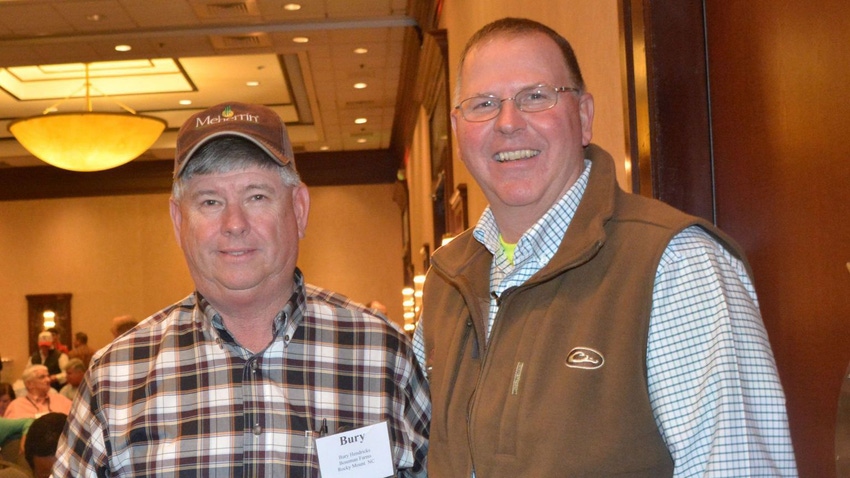
In the 2017 National Corn Growers Association Yield Contest, Charles City, Va. farmer David Hula scored the highest yield ever: a whopping 542.270 bushels per acre. At this year’s North Carolina Commodities Conference in Durham Jan. 11 he shared some of the steps that got him there.
Among his keys to success: a micronutrient cocktail, a planting depth of 1 ¾ inches and tissue sampling. All of Hula’s ground is no-till or “never till” as he puts it and job one is striving for even emergence.
Hula farms with his brothers John and Jeff. David’s son Craig is also involved. The brothers are the third generation of Hulas to run Renwood Farms that provides high-quality cereal and soybean seed to farmers throughout the Southeast and Mid-Atlantic.
Hula’s record breaking entry was in the contest’s strip-till/no-till irrigated division. He achieved the top yield in the contest with the hybrid Pioneer P1197 AM. Hula’s son Craig took second place in the same division with a yield of 529.1376 with the hybrid DEKALB DKC6744RIB, and Hula’s brother Johnny placed third in the division with a yield of 504.6890 with the hybrid Progeny PGY5115VT2P.
“We don’t have a magic piece of dirt. We’re farming fine sandy loam soils. We have a pretty deep soil profile, but it is fine sandy loam. Because of our sandy soils and lack of manure our nutrient levels are not excessively high,” Hula said at the Durham conference.
“Your goal should be to have enough nutrients available to your crop in a form in which the crop can use it and to assure this we use tissue sampling, That’s how we manage our nutrients. We give it a baseline and then we predict. We have been pulling tissue samples on a weekly basis for10 years now," he said.
Increasing kernel count and influencing the growth of the ear is vital. Hula says the use of a micronutrient cocktail that includes copper, iron, boron, zinc, manganese and molybdenum is vital for getting there. The Hulas apply the micronutrient cocktail at V-4 on all of their acreage.
“On high-yielding environments it is a standalone application with some humic acids, carbon source and PGRs, and on regular production it is tank mixed with our herbicides,” Hula said.
The Hulas like to keep their soil pH closer to 6 rather than at 6.5 that is common in the Midwest. They make a lime application in front of their crop only when the pH dips below 5.8. They apply lime once every three to four years. Hula notes that they make micronutrient applications to assure availability despite the soil pH.
Potash is a must for big yields and the Hulas apply potash in front of their corn crop. “Corn is a big luxury consumer of potash. It’s just going to soak it up. It takes almost as much potash as nitrogen, almost a one-to-one ratio,” Hula said.
Corn will use the potash and then release it to small grains and soybeans which the Hulas plant following corn. They apply 200 to 250 pounds of potash per acre based on soil sampling. The Hulas like to add fertilizer in furrow and also use starter.
The Hulas strive to make their crop nutritionally balanced, which is why tissue sampling is important. They use starter fertilizer and also add fertilizer in furrow. In addition to applying the micronutrient cocktail at V-4, they put down five gallons of 3-18-18 foliar fertilizer at V-5 and a side-dress of 160-0-205. A the V-8 stage, they make a side-dress application of 80N-10S then at pre-VT stage they put on additional nitrogen and sulfur depending on their yield goal.
Hula says he likes entering the NCGA corn yield contest each year because it encourages him to try something new. Like many in the corn business, Hula sees even more potential for yield gains in the years to come. He notes that seed companies are making it easier for farmers to build yields by providing ever improving hybrids.
“I think the genetic potential for corn today is 800 bushels. There is no way Randy Dowdy (the Valdosta, Ga. grower who was the top finisher in the 2016 contest with a yield of 521 bushels per acre irrigated) or myself have captured all the genetic potential. If 800 is the actual number and the country averages170 bushels, we have a long way to go. I think down the road we as producers will tap into the higher yields, but it will take a team effort and favor from the good Lord," he said.
About the Author(s)
You May Also Like






